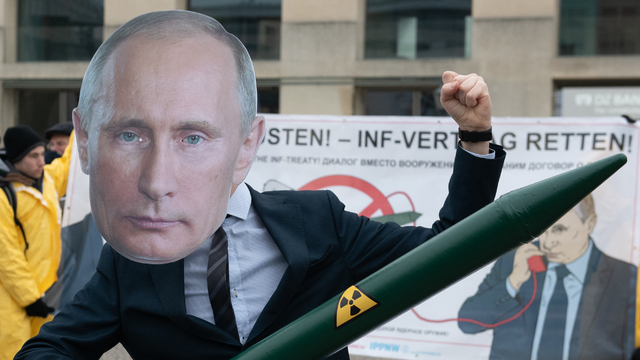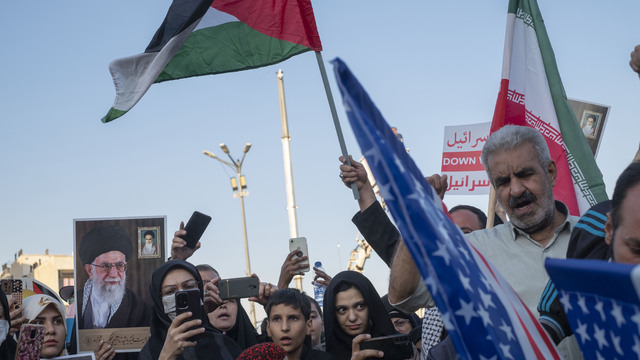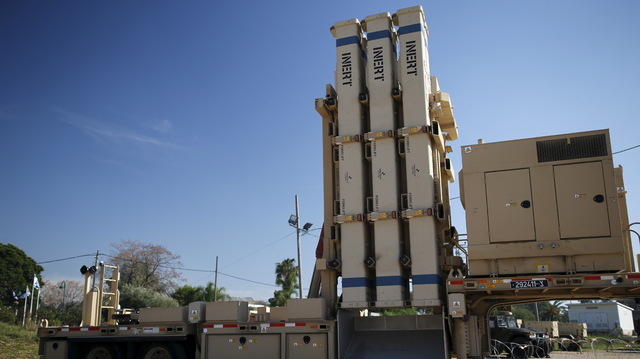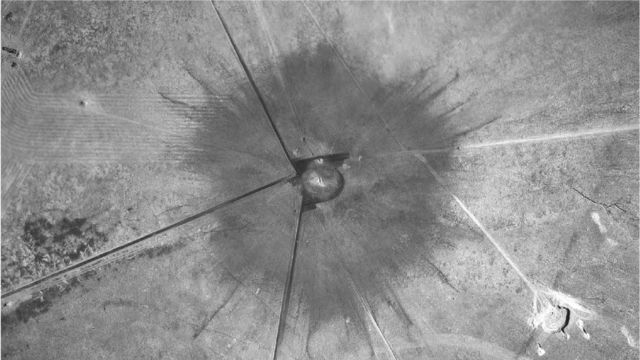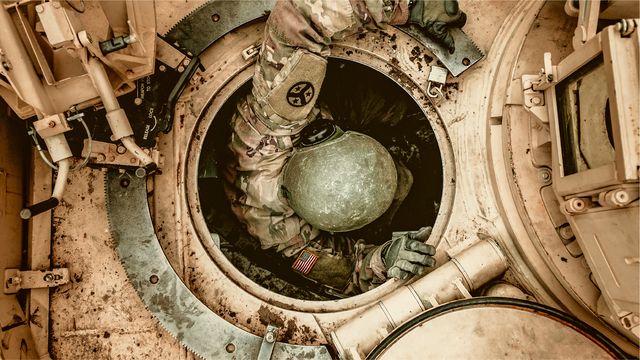WILL THE MEASURES TO PREVENT NUCLEAR PROLIFERATION SUCCEED?

The reflection addresses the security threat of nuclear proliferation, which is understood here primarily as an increase in the number of nuclear weapon states.
There are currently nine nuclear weapon states: the US, Russia, China, France, the UK, India, Pakistan, Israel and the DPRK. Of the approximate number of more than 12,000 nuclear warheads, the US and Russia have about 90%. At the same time, however, nuclear proliferation can be understood as a possible increase of the number of non-nuclear weapon states with nuclear weapons deployed on their territory by one of the two major nuclear powers. The topicality of the threat is underlined by the examples given in the reflection of the main risky regions, which are the Korean Peninsula, Europe (as a result of the war in Ukraine), and the Middle East (in connection with the so-called Iranian nuclear programme). The reflection also looks at the issue in the context of international law and other measures to address it. The conclusions particularly point to the negative effects of the deterioration of the US-Russian relations and the stagnation in addressing the risky regional issues on the global security development.
THE CAUSES AND THE NATURE OF THE SECURITY
THREAT OF NUCLEAR PROLIFERATION
With the energy crisis and climate change, the number of states seeking a peaceful use of nuclear energy is increasing. In the field of energy the construction of nuclear power plants is a major concern. By building nuclear facilities and possibly also the associated nuclear fuel cycle to enrich uranium, some of these countries are becoming so-called threshold states. These are states which, given their advanced personnel and technological capacities, could relatively quickly switch to the military use of nuclear energy in addition to the peaceful use if a decision to do so were taken. These countries include Brazil, Argentina, Sweden, South Korea and some others.
A hypothetical political decision by a countryʼs leadership to embark on a military nuclear programme should be followed by its withdrawal from the Nuclear Non-Proliferation Treaty (NPT) and possibly a termination of its membership in a regional nuclear-weapon-free zone. The consequence would be a complicating of international efforts to mitigate the risk of nuclear war and a weakening of the global nonproliferation regime with the NPT as its cornerstone. In such a case, the international community would probably adopt a tough sanction regime against such a country. Rival power considerations, including military threats, unresolved territorial disputes, and possibly a desire to enhance the given country’s international prestige, have been identified as the main reasons for nuclear proliferation.
The two leading nuclear powers, the US and Russia, are not interested in such an increase in the number of nuclear-weapon states. They therefore address the security concerns of their allied and partner countries by including them in the extended nuclear deterrence. In this way, the US protects all NATO member countries and the so-called partner states such as, e.g., Japan and South Korea. Russia places mainly Belarus and some other member states of the Commowealth of Independent States (CIS) under its nuclear protection.
In the case of the deployment of nuclear weapons on the territory of a non-nuclear weapon state, which reinforces the nuclear deterrence, a security risk arises for the host state. It is a realistic assumption that nuclear weapon bases will be among the first targets of an adversary when a regional conventional armed conflict breaks out with the threat of its escalation into nuclear war. For NATOʼs new members that are non-nuclear weapon states, there is still a restraint regarding such deployment. It is represented by the Founding Act concluded between NATO and Russia in 1997. In the text regulating their mutual relations, there is, among other things, a statement by the alliance states that they “have no intention, plan or reason to deploy nuclear weapons on the territory of the new alliance countries…”
INTERNATIONAL LEGAL REGULATION AND EXPORT CONTROL REGIMES
THE NPT AND THE TPNW
The two main international legal instruments in force that relate to nuclear weapons are the Nuclear Non-Proliferation Treaty (NPT) and the Treaty Prohibiting Nuclear Weapons (TPNW). The NPT, which has been in force from 1970, has an almost universal membership with its 191 states parties. It is not a nuclear disarmament treaty and does not deal with the issue of the deployment of nuclear weapons on the territory of a non-nuclear weapon state. The only article of the treaty that deals with nuclear disarmament, Article VI, is too vague. The treaty legalises the possession of nuclear weapons by the five permanent members of the Security Council (the USA, Russia, France, China and the UK). The remaining nuclear weapon states (India, Pakistan, Israel and the DPRK) are not NPT states parties.
Most of the treatyʼs articles are focused on measures to prevent the proliferation of nuclear weapons and promote the peaceful use of nuclear energy. An important control role has been played in this effort by the International Atomic Energy Agency (IAEA) through the Comprehensive Safeguards Agreements and possibly also their Additional Protocol, which tightens verification measures. Military nuclear facilities of nuclear weapon states, however, are not subject to the verification activities.
The TPNW, which prohibits and delegitimises nuclear weapons, was negotiated in 2017 and entered into force in January 2021. In addition to prohibiting the development, testing, production, possession, procurement, stockpiling, use and threat of use of nuclear weapons, the prohibition includes their deployment by nuclear weapon states in non-nuclear weapon states. The TPNW is not supported by any of the nuclear weapon states, or their alliance and partner countries. However, last June´s first meeting of the treaty countries was attended by Germany and the Netherlands, on whose territories US tactical nuclear weapons are deployed.
EXPORT CONTROL REGIMES
To support efforts to prevent the proliferation of mass destruction weapons and their delivery systems, four non-treaty groupings consisting of several dozen mostly industrialised states, have been established. Their purpose is to control transfers of items under the export control regime.
In relation to nuclear weapons, the relevant groupings are the Zangger Committee (ZC) and the Nuclear Suppliers Group (NSG), whose activities support the role of the NPT. The ZC is the first ever export control regime for nuclear weapons, and its creation is directly linked to Article III of the NPT, which leads to its widespread support. The NSG differs from the ZC primarily in that the former no longer distinguishes between the applicability of controlled elements in the civilian and the military sector.
Other export control regimes include the Australia Group (AG), which focuses on chemical and biological weapons issues, and the Missile Technology Control Regime (MTCR), which is dedicated to the prevention of proliferation of mass destruction weapon delivery systems.
HIGH RISK REGIONS
THE KOREAN PENINSULA
Since the end of the three years’ war in 1953, the Korean Peninsulaʼs conflict still has not been finished by the signing of a peace treaty. Thus, only an agreed ceasefire remains in force in the region, which is divided by the 38th parallel, which separates the two Korean states.
On January 12 of the same year the South Korean conservative President Yoon Suk Yool mentioned at a joint briefing with the foreign and defence ministers the possibility of starting nuclear weapons production in the country. He made the move conditional on the possible reluctance of the US to deploy nuclear weapons in the country. He subsequently tempered his statement by claiming that this is not yet the official policy of the country, which intends to continue to respond to the North Korean nuclear threats by strengthening its alliance with the US. In the past, South Korea twice violated provisions of the NPT, to which it has been a party since April 1975: In the 1970s, during the military dictatorship of Park Jong-hui, the country pursued a covert nuclear military programme. Then in 2004, the countryʼs leadership officially admitted to a secret programme to enrich uranium for military use, which was allegedly carried out without the governmentʼs knowledge. Under US pressure, the country ended the illegal programmes. Otherwise, the US had nuclear weapons in the country until 1991, when it withdrew them as part of the then-current reduction in the number of its nuclear weapons in the world. However, it continues to maintain a military base in the country with approximately 30,000 troops. Its importance is growing as the security relations with Russia and China, which border the Korean Peninsula, deteriorate.
As for the DPRK, it withdrew from the NPT as a result of its nuclear military programme. As the reason for its withdrawal, it cited the security threat to the country for its not fulfilling the 1994 agreement with the US, which obliged it to provide assistance in building nuclear power plants, and the commitment to normalise the relations with the US. The country also conducted six nuclear tests between 2006 and 2017.
Under the Trump administration, there have been relatively promising developments in inter-Korean relations and the DPRK relations with the US during 2018. The exceptional efforts of the then South Korean president Moon Jae-in played a positive role in them. In April 2018, the North Korean leadership announced, among other things, a moratorium on intercontinental ballistic missile and nuclear tests as a sign of goodwill. At that time, the Trump administration also significantly reduced the intensity of the US-South Korean military exercises. Following the failure of Trumpʼs summit with Kim Jong-un in Hanoi in late February 2019, which was blamed on both sides, and the subsequent significant deterioration in the DPRKʼs relations with the US, the North Korean leader announced the lifting of the aforementioned moratoriums. In September 2021, the South Korean President Moon Jae-in, whose five-year term ended in May 2022, addressed the UN General Assembly with a significant proposal to resolve the Korean issue. In it, he called for, among other things, “the two Koreas and the US, or […] the two Koreas, the US and China [to] come together and declare that the War on the Korean Peninsula is over”. However, the proposal did not generate any practical response from the parties involved.
In late March 2022, the DPRK conducted a test of a long-range ballistic missile (Hwasong 17) and subsequently conducted a series of tests of various types of missiles, mostly tactical in nature, with a range of up to 500 km. In September of the same year, the country passed a law specifying its nuclear doctrine. The law officially declared the DPRK a nuclear weapon state that would not participate in any arms control negotiations, and stressed the sole responsibility of the North Korean leader for the use of nuclear weapons. It also did not rule out the possibility of a nuclear first strike and for the first time mentioned the automatic detonation of nuclear weapons in the event of a targeted attack aimed at decapitating the countryʼs leadership.
The Biden administration has so far shown no concrete responsive activity towards the DPRK. The North Korean side has rejected the occasional US general calls for a resumption of the talks “without preconditions.” In the context of the main security challenge in the Asia-Pacific region, posed by China, the US is primarily focused on deepening its military relations with Japan and South Korea.
THE EUROPEAN REGION
The European region is not yet threatened by an emergence of new nuclear weapon states in it, but rather by an increase in the number of non-nuclear weapon states on whose territories nuclear weapons may be deployed.
Following the launch of the Russian invasion of Ukraine on 22 February 2022, three days later Belarus approved its new constitution, which enables the deployment of nuclear weapons on the Belarusian territory. This was followed in June 2022 by the conclusion of an agreement between Belarus and Russia on the adaptation of Belarusian Su-25 aircraft for use as nuclear delivery systems, and the planned transfer of Russian Iskander-M mobile missile systems to Belarusian territory. This missile system can launch ballistic missiles or cruise missiles with conventional or nuclear warheads with a range of up to 500 km. The completion of the project was announced by the Belarusian Ministry of Defence at the end of the last year. On March 25, 2023 Russian President Vladimir Putin announced that the the storage facility for the nuclear ammunition deployed on the Belarusian territory will be ready by the 1st of July of the same year. He has not mentioned, however, the time of the nuclear weapons’ deployment.
Within NATO, US tactical nuclear weapons in the form of gravity bombs have been forward deployed in five non-nuclear weapon countries (Germany, the Netherlands, Belgium, Italy and Turkey) since the Cold War. Under the Nuclear Sharing Arrangements, pilots from the host countries are trained on so-called dual-use aircraft, i.e. as carriers of both conventional and possibly nuclear weapons.
Poland has also expressed an interest in joining the allianceʼs nuclear sharing system because of the Russian security threat. In October 2022, Polish President Andrzej Duda held talks on the subject in the US. However, according to a subsequent statement by the US State Department spokesman, the US does not intend to deploy nuclear weapons in the new alliance countries.
THE MIDDLE EAST
The Iranian nuclear programme
In 2018, the Trump administration unilaterally withdrew from the Joint Comprehensive Plan of Action (JCPOA). This policy document, approved in Vienna in 2015, prevented Iranʼs access to nuclear weapons while lifting major anti-Iranian sanctions. In addition to Iran, all members of the UN Security Council, as well as Germany and the EU in a coordinating role, participated in the multi-year negotiating process. The IAEA inspectors monitored the implementation of the document. President Trump justified his withdrawal by claiming that the document was not well negotiated. The main opponents of the agreement in the US were mainly Republican congressmen, and those from abroad were mainly Israel and Saudi Arabia, as well as several other Sunni Arab Gulf states.
After the US withdrawal, Iran has mainly upgraded its centrifuge enrichment facilities since 2019 and carried out uranium enrichment without restrictions, but up to a maximum of 60%, as militarily usable uranium is enriched to around 90%.
With the arrival of the Biden administration, negotiations were launched in Vienna in 2021 to renew the US membership in the agreement and return Iran to compliance with its agreed commitments. The negotiations were conducted in the form of “indirect talks”, i.e. by the JCPOA participants with the exception of the US delegation. However, the US delegation was kept informed of the developments.
In the middle of the year, the negotiations were suspended for several months due to the presidential election in Iran. Iranʼs new conservative leadership then expressed interest in resuming the talks and also renewed an agreement with the IAEA to continue the verification and monitoring inspection activities at Iranʼs nuclear facilities. The subsequent negotiations can be characterised as difficult, inter alia due to Iranʼs demand for guarantees from the US prior to the latter’s possible reneging on the agreement once again. Iran, on the other hand, refused, for example, the IAEAʼs request to provide documents on the implementation of its nuclear military programme until 2003, when the country had ended its programme according to a report of the US National Intelligence Estimate (NIE).
During 2022 and early 2023, the negotiations taking place in Doha, Qatar were negatively affected primarily by Iranʼs support for Russiaʼs war in Ukraine, which included supplying Russia with drones and brutally suppressing Iranian anti-government demonstrations. In Iran, on the other hand, there have been several anonymous terrorist activities, which were generally attributed to Israel.
The position of Israel and Saudi Arabia
Already during the negotiation of the original JCPOA, Israeli and Saudi Arabian officials called on the US to carry out military strikes on Iranʼs nuclear facilities, among other things. Their unequivocally negative approach has not changed even as regards the renewed negotiations.
In Israel, a new government was created late last year, and it is led by the restored Prime Minister Benjamin Netanyahu of the conservative Likud Party. The government coalition also includes representatives of far-right and ultra-Orthodox parties. It can therefore be expected to take a very hard line against Iran and the negotiations on a new deal. Prime Minister Netanyahu has already identified stopping Iranʼs nuclear programme as one of the governmentʼs three priorities.
As for Saudi Arabia, as part of its ambitious nuclear energy development plan, it intends to build a nuclear fuel cycle, including the production of low-enriched uranium. In January of this year, the Saudi Energy Minister Prince Abdulaziz bin Salman confirmed this intention. According to an earlier statement by Saudi Arabiaʼs ruler Crown Prince Mohammed bin Salman, his country has no interest in possessing nuclear weapons. At the same time, however, he added that if Iran produced such weapons, Saudi Arabia would also acquire them as soon as possible.
CONCLUSIONS AND FURTHER EXPECTED DEVELOPMENTS
The DPRK defends its possession of nuclear weapons with arguments about nuclear deterrence, particularly in the context of the US military exercises with South Korea and Japan. To enforce its demands for security guarantees and limitations on the sanctions regime, it is taking a coercive path by demonstrating its military capabilities, including through its drone provocations against its southern neighbour. It continues to observe the moratorium on nuclear testing, however.
Taking into account the crisis developments in the Middle East in all their aspects, the only realistic alternative to resolving the problem of Iranʼs nuclear programme appears to be an accelerated finalisation of a compromise agreement to replace the JCPOA.
The stagnation in addressing the denuclearisation of the Korean Peninsula and in negotiating a new so-called Iranian nuclear deal creates a high risk of unpredictable developments in these regions. One of the reasons for the stagnation is the preferential focus of US foreign and military policy on Russia and China. The domestic political developments in the US may also play a role, given the weakened position of President Biden and the uncertain outcome of the contest between the two main political parties in the upcoming presidential elections in 2024.
The continuing deterioration of the US-Russian relations, and the escalation of the arms race, especially in the context of the war in Ukraine and its imminent resolution, are contributing to the growing security tensions in the world and especially in the European region. This situation has led to an increased interest of some non-nuclear European countries in strengthening their security by deploying nuclear weapons on their territories.
Also, concerns about the possibility of the use of nuclear weapons in Europe have increased due to President Putinʼs confirmation of the deployment of tactical nuclear weapons in Belarus.
